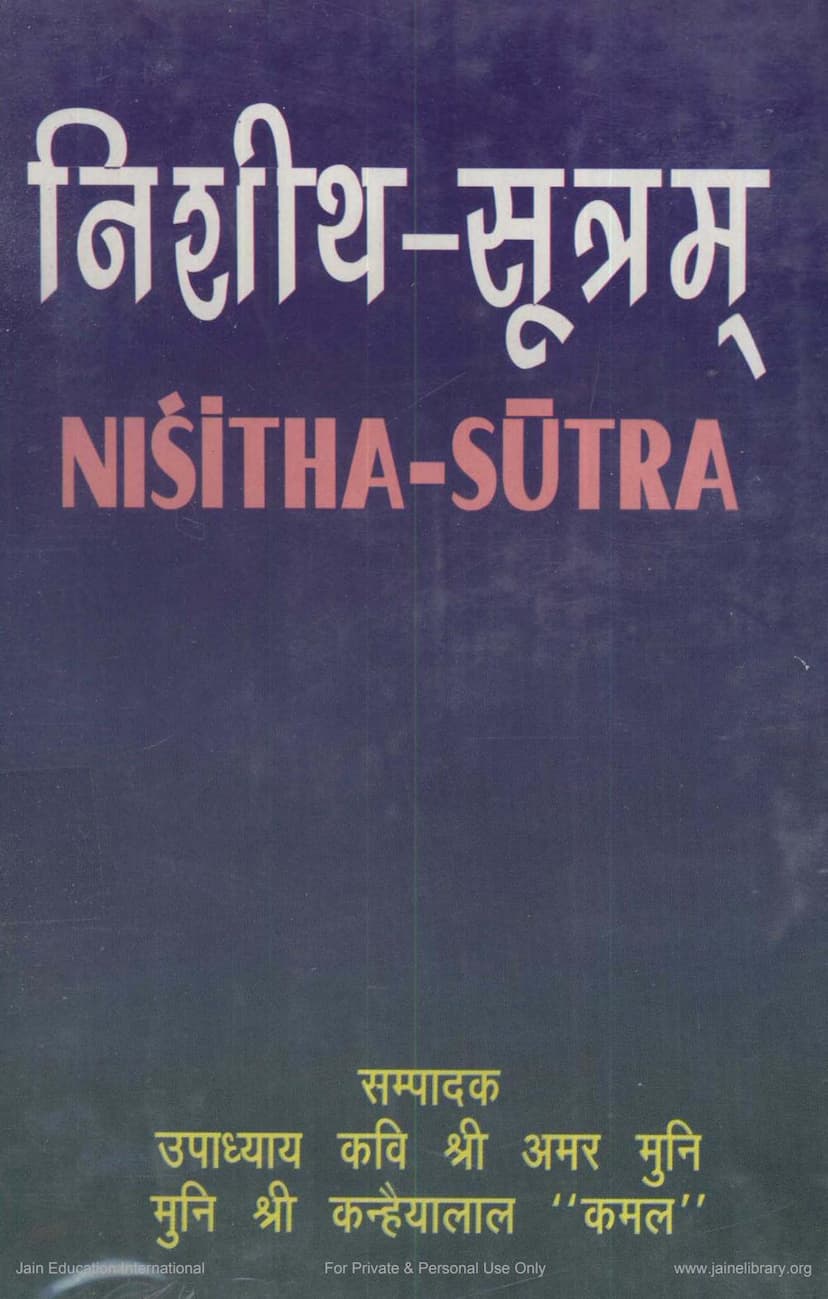Agam 24 Chhed 01 Nishith Sutra Part 01 Sthanakvasi
Added to library: September 1, 2025

Summary
This is a summary of the Jain text "Nishith Sutra Part 01" by Upadhyaya Kavi Shri Amar Muni Ji Maharaj and Muni Shri Kanhaiyalal Ji Maharaj "Kamal", published by Amar Publications, Varanasi.
Book Title: Nishith Sutram (NIŠITHA-SŪTRA) Part: Part 01 (First Volume) Editors: Upadhyaya Kavi Shri Amar Muni Ji Maharaj and Muni Shri Kanhaiyalal Ji Maharaj "Kamal" Publisher: Amar Publications, Varanasi Edition: Second Edition (in this type reprint) Price: Rs. 1200.00 (for complete set in four parts) Edition Year: 2005
About the Book:
The Nishith Sutra is a highly important Agama text within Jainism, particularly for the Svetambara sect. It is a foundational text on Jain monastic disciplinary rules and conduct. Its significance is further amplified by the Bhashya (commentary) of Sthavir Pungava Shri Visahagani Mahattar and the Churni (elaborate commentary) of Jinadasa Mahattara.
Key Aspects and Significance:
- Encyclopedic Knowledge: The Nishith Sutra, supplemented by its commentaries, is described as an encyclopedia of knowledge.
- Monastic Discipline: It deals extensively with the rules and regulations of conduct for Jain ascetics (monks and nuns), covering various aspects of their daily life and spiritual practice.
- Contextual Conduct: The Bhashya specifically highlights the importance of conduct tailored to specific times and places, reflecting a practical approach to spiritual life.
- Historical and Cultural Insights: Beyond its religious and ethical content, the Bhashya offers valuable insights into the cultural, political, and social aspects of the period when the Bhashyakara lived.
- Elucidation of Acārānga: The work is noted for elucidating and elaborating on the thoughts contained in the Acārānga Sutra, making the study of early Jainism more accessible.
- Rules for Self-Realization: The text lays down rules for self-realization for both ascetics and householders, encompassing a holistic approach to spiritual life.
- Utsarga (Fundamental) vs. Apavada (Exceptional) Principles: A significant theme explored is the distinction between fundamental principles (utsarga) and exceptions (apavada) to these rules. The text explains how exceptions emerged due to evolving societal conditions, time, and place, and how they were integrated into the broader framework of conduct. These exceptions were often necessitated to make the observance of rules practical and convenient for ascetics, preventing them from being perceived as entirely impracticable.
- The Role of Commentaries: The necessity of commentaries like Niryukti, Bhashya, and Churni is emphasized, as they help in interpreting the multifaceted meanings of the sutras and clarifying the distinction between utsarga and apavada. The emphasis is placed on the meaning (artha) rather than just the word (shabda).
- Ahimsā and its Nuances: Ahimsa (non-violence) is presented as the core of Jain ethics. The text discusses how, even within the strict adherence to Ahimsa, exceptions and interpretations arose to address complex situations, demonstrating a balance between principle and pragmatism.
- Prāyaścitta (Expiation): The Nishith Sutra is rich in detailed references to the need and value of prāyaścitta (expiation) for various transgressions of rules. The commentaries delve into the methods and significance of expiation for self-purification.
- Social and Historical Context: The text is a treasure trove of information about the social, political, and historical situations of ancient India, making it a valuable resource for research.
- Adaptability and Flexibility: The summary notes that Jain monastic life, while emphasizing self-control, also demonstrated adaptability to social, cultural, and geographical conditions, allowing for exceptions to maintain the solidarity and progress of the community.
- Sthānakavāsī Tradition: The introduction to this specific publication hints at the Sthānakavāsī tradition, which emerged from a movement to reform or re-examine certain practices, including idol worship.
This specific edition is Part 01, focusing on the "Peethika" (Introduction/Preamble). It serves as a comprehensive introduction to the Nishith Sutra, its commentaries (Bhashya and Vishesh Churni), and the broader context of Jain Agamic literature and monasticism. The editors, Kavi Shri Amar Muni Ji Maharaj and Muni Shri Kanhaiyalal Ji Maharaj "Kamal", are credited for their significant contribution in bringing this authoritative edition to scholars and institutions. The reprinting indicates a high demand and continued relevance of this crucial Jain text.